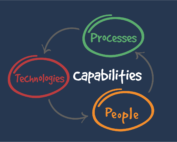Strategic objectives, design principles and dangerous deviations
So many aspects of functional transformation are unknown and unknowable when you begin. By their nature these programmes are disruptive, often formed in response to existential threats or urgent opportunities. Timelines can stretch well beyond the annual budgeting cycle and information often builds over time, putting us deep into the territory of unknown unknowns. A compelling vision of the future, documented objectives and clear design principles will help guide your path, even as the landscape shifts around you.
This is the fourth in our series of articles that seek to answer the question of why so many transformation initiatives fail and, more importantly, provide practical guidance for success. This week we consider our destination, the different ways of describing it to ourselves and to others, and the guide rails that will keep us on track.
What your team need is clear, simple direction that allows them to make decisions in the moment that will ultimately get you to your destination. Your vision, objectives and design principles provide guidance to your team, helping them to decide where to go and what to do.
Your vision is a description of your destination. It should be concise, compelling and engage at an emotional level. The best vision statements use words and pictures to convey the destination, the reasons for change and prepare people for the journey ahead. A good vision attracts support and incites people to action.
But vision only gets you so far. To make appropriate decisions en route, your team need more granularity and guidance, which is where strategic objectives and design principles come in. Strategic objectives provide detail about the outcomes that must be delivered. They should be SMART objectives that can be distributed and owned by members of your leadership team. They act as a touchstone during design and they define progress and success – as in, does this decision get us closer or further away from delivering our strategic objectives?
Design principles act as a compass, focusing more on direction than defining the destination. They should be between 4 and 8 simple, unambiguous statements, each with a brief description of the philosophy that will guide how decisions are going to be made.
Design principles should be used throughout the programme, not just in the design phase. New processes and systems should be checked against design principles, during the testing phase, for example.
Any decisions to deviate from a design principle should be carefully considered and a record kept of the reasons behind the deviation. Too often decisions that were made for sound, sensible reasons become unfathomable just a few months after the ‘go live’ date, and days after the programme team and all the consultants have left and moved on to their next client.
Next week we look at some of the methodologies you can use to deliver transformational change, the differences between projects, programmes and portfolios, and the importance of selecting the right approach for your transformation, in our article on ‘Methodology and Approach’.
Can’t wait until next week? For your full 10 point Transformation Scoping Checklist click here.
Please get in touch via email, LinkedIn, or Twitter @UnderscoreComms, if you have questions, comments, or would like to know more, we’d love to hear from you.
This article on Vision, Objectives and Design Principles is the sixth of ten critical success factors in scoping a functional transformation programme. Other articles in this series include:
- The first article covered the first three points from our scoping checklist, namely Sponsorship, Problem Definition and Preparing for Change
- The second article focused on Requirements Gathering and the importance of looking beyond technology
- Governance and Decision Making was the topic of the third article and the financial impact of governance that breaks down
Read Next
Transformation Checklist #10: Business Case
Where the rubber hits the road So you’re sponsoring a transformation programme and you and your team have spent the past six months setting up governance, understanding what needs to change, gathering requirements, selecting [...]
Transformation Checklist #9 – Solution Design Capability
NOT business as usual, please This is the seventh in our series of articles that consider why so many transformation initiatives fail and, more importantly, what can you do to improve your chances of [...]
Transformation Checklist #8: Programme management capability
This is the sixth in our series of articles that consider why so many transformation initiatives fail and, more importantly, what can you do to improve your chances of success. Last week we looked [...]
Transformation Checklist #7: Methodology and approach
Why do so many transformation initiatives fail and, more importantly, what can you do to improve your chances of success? This is the fifth in our series of articles that seek to answer these [...]
Transformation Checklist #5: Governance and decision making
Destructive forces, burn rates and protecting scope There are three mistakes you can make in defining the governance structure of your functional transformation: Holding too much decision making at the top of the structure [...]
Transformation Checklist #4: Requirements gathering: beyond technology
Welcome to the second in a series of articles that seek to answer the question of why so many transformation initiatives fail and provide practical guidance for success. Many transformation programmes mean changes to [...]






